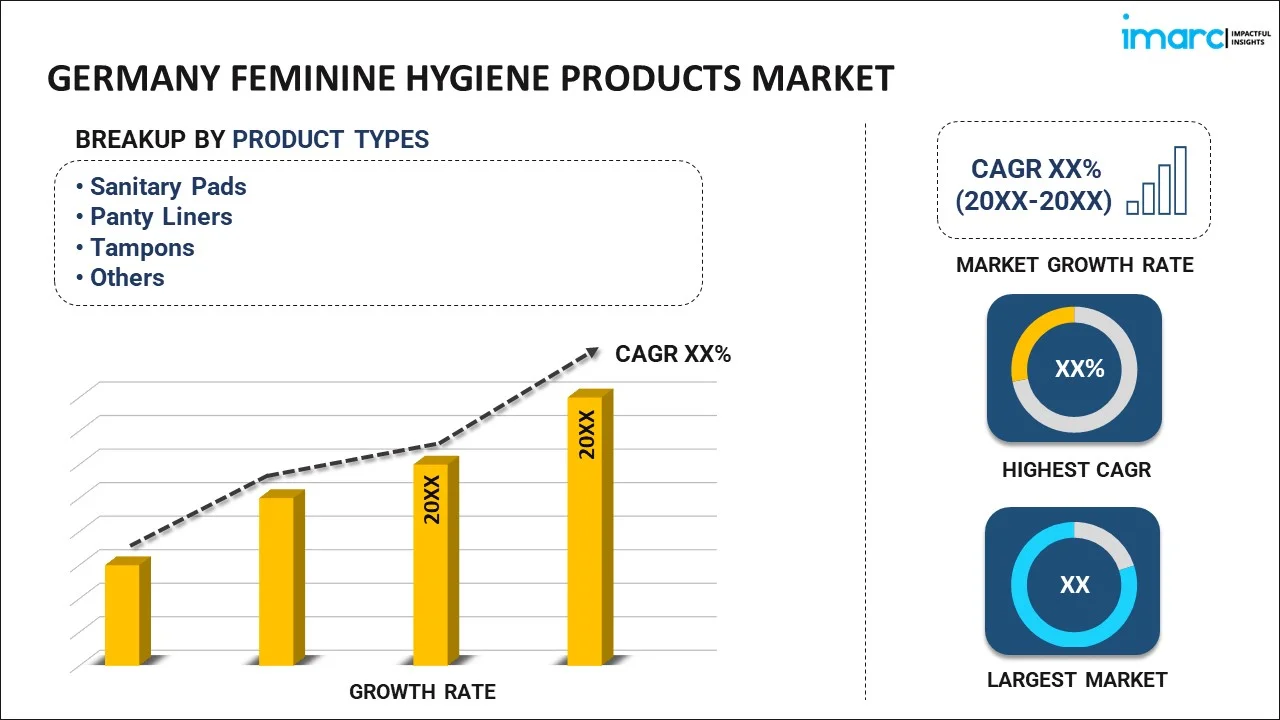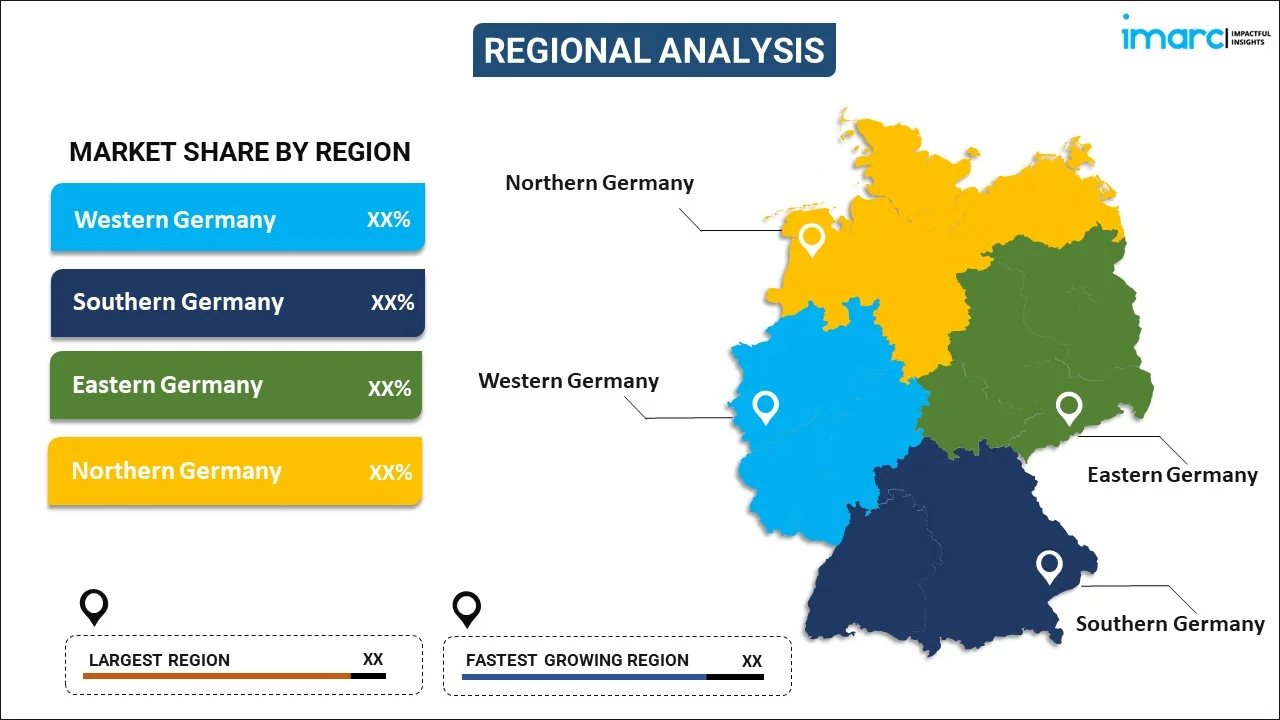
Germany Feminine Hygiene Products Market Report by Product Type (Sanitary Pads, Panty Liners, Tampons, Spray and Internal Cleaners, and Others), Distribution Channel (Supermarkets and Hypermarkets, Specialty Stores, Beauty Stores and Pharmacies, Online Stores, and Others), and Region 2025-2033
Germany Feminine Hygiene Products Market Overview:
The Germany feminine hygiene products market size reached USD 1.3 Billion in 2024. Looking forward, IMARC Group expects the market to reach USD 1.9 Billion by 2033, exhibiting a growth rate (CAGR) of 3.94% during 2025-2033. Germany feminine hygiene product market is primarily driven by the rising demand for organic, ecofriendly and innovative products like period panties, organic tampons, and advanced absorption pads. Heightened awareness campaigns, the rise of e-commerce, and a strong emphasis on sustainability and consumer health are also propelling the market growth.
|
Report Attribute
|
Key Statistics
|
|---|---|
|
Base Year
|
2024
|
|
Forecast Years
|
2025-2033
|
|
Historical Years
|
2019-2024
|
|
Market Size in 2024
|
USD 1.3 Billion |
|
Market Forecast in 2033
|
USD 1.9 Billion |
| Market Growth Rate 2025-2033 | 3.94% |
Germany Feminine Hygiene Products Market Trends:
Rising Awareness and Education Campaigns
Awareness and education campaigns are playing an important role in reshaping the perceptions and encouraging the use of feminine hygiene products in Germany. These initiatives mainly aim to break longstanding taboos surrounding menstruation by encouraging open conversations and disseminating accurate information about menstrual health. For instance, Menstrual Hygiene Day is celebrated in Germany on May 28th of every year. This day was initiated by German nonprofit organization WASH United in year 2013. This day aims to challenge stigmas and advocate for proper menstrual health and hygiene across the world. Various organizations and brands are collaborating with healthcare professionals, schools, and influencers to reach a broader range of audience, ensuring that both young girls and women are well informed about their options. Campaigns often focus on importance of menstrual hygiene, the benefits of various products, and the environmental impact of disposable items. Social media platforms and community outreach programs are also utilized to create engaging and relatable content that resonates with diverse audiences.
Innovative Product Offerings
Innovative product offerings in feminine hygiene market are transforming consumer experiences through cutting edge research and development (R&D). Period panties, designed with leak proof technology, provide a reusable, comfortable, and ecofriendly alternative to traditional products, further enhancing their appeal to a wide array of consumers. Organic tampons with applicators are gaining popularity for their chemical free, biodegradable material that prioritizes user health and environmental responsibility. These tampons often come with easy-to-use applications, enhancing convenience and hygiene. Plastic period products rank as the fifth most common single-use plastic item found on European beaches, surpassing plastic cups and straws. In response to the growing demand for eco-friendly period products, a German startup called Vyld has developed biodegradable tampons made from seaweed. Launched in 2021, Vyld's "Kelpon" tampons are crafted from a biopolymer derived from marine algae, which is processed into fibers using traditional tampon production methods. Additionally, pads with advanced absorption technology incorporate superabsorbent polymers and moisture-wicking layers, ensuring superior dryness, comfort, and protection against leaks. These pads often feature ergonomic designs to fit different body shapes and active lifestyles. Such innovations reflect a deep understanding of consumer needs and a commitment to enhancing comfort, health, and sustainability in menstrual care products, setting new standards in the market.
Germany Feminine Hygiene Products Market News:
In 2024, Thinx introduced a new period product style with LeakSafe™ Barrier technology, offering up to 12-hour leak protection. The patent-pending 4-layer gusset provides comfort and absorbency, reducing the need for disposable products. Thinx aims to improve period care standards, providing dryness and comfort all day. The products are available at various price points and are certified for safety and quality.
In 2023, Metsä Group invested EUR 1 million in FineCellOx AB, a Swedish developer of the FineCell technology, to enhance its material application capabilities and finalize plans for a demo production facility. The technology transforms pulp into sustainable biomaterials, offering a potential alternative to fossil-based chemicals in various industries. FineCell aims to have a demo plant ready for investment by 2024 and commence full commercial production by 2027.
Germany Feminine Hygiene Products Market Segmentation:
IMARC Group provides an analysis of the key trends in each segment of the market, along with forecasts at the country level for 2025-2033. Our report has categorized the market based on product type and distribution channel.
Product Type Insights:

- Sanitary Pads
- Panty Liners
- Tampons
- Spray and Internal Cleaners
- Others
The report has provided a detailed breakup and analysis of the market based on the product type. This includes sanitary pads, panty liners, tampons, spray and internal cleaners, and others.
Distribution Channel Insights:
- Supermarkets and Hypermarkets
- Specialty Stores
- Beauty Stores and Pharmacies
- Online Stores
- Others
A detailed breakup and analysis of the market based on the distribution channel have also been provided in the report. This includes supermarkets and hypermarkets, specialty stores, beauty stores and pharmacies, online stores, and others.
Regional Insights:

- Western Germany
- Southern Germany
- Eastern Germany
- Northern Germany
The report has also provided a comprehensive analysis of all the major regional markets, which include Western Germany, Southern Germany, Eastern Germany, and Northern Germany.
Competitive Landscape:
The market research report has also provided a comprehensive analysis of the competitive landscape. Competitive analysis such as market structure, key player positioning, top winning strategies, competitive dashboard, and company evaluation quadrant has been covered in the report. Also, detailed profiles of all major companies have been provided.
Germany Feminine Hygiene Products Market Report Coverage:
| Report Features | Details |
|---|---|
| Base Year of the Analysis | 2024 |
| Historical Period | 2019-2024 |
| Forecast Period | 2025-2033 |
| Units | Billion USD |
| Scope of the Report | Exploration of Historical Trends and Market Outlook, Industry Catalysts and Challenges, Segment-Wise Historical and Future Market Assessment:
|
| Product Types Covered | Sanitary Pads, Panty Liners, Tampons, Spray and Internal Cleaners, Others |
| Distribution Channels Covered | Supermarkets and Hypermarkets, Specialty Stores, Beauty Stores and Pharmacies, Online Stores, Others |
| Regions Covered | Western Germany, Southern Germany, Eastern Germany, Northern Germany |
| Customization Scope | 10% Free Customization |
| Post-Sale Analyst Support | 10-12 Weeks |
| Delivery Format | PDF and Excel through Email (We can also provide the editable version of the report in PPT/Word format on special request) |
Key Questions Answered in This Report:
- How has the Germany feminine hygiene products market performed so far and how will it perform in the coming years?
- What has been the impact of COVID-19 on the Germany feminine hygiene products market?
- What is the breakup of the Germany feminine hygiene products market on the basis of product type?
- What is the breakup of the Germany feminine hygiene products market on the basis of distribution channel?
- What are the various stages in the value chain of the Germany feminine hygiene products market?
- What are the key driving factors and challenges in the Germany feminine hygiene products?
- What is the structure of the Germany feminine hygiene products market and who are the key players?
- What is the degree of competition in the Germany feminine hygiene products market?
Key Benefits for Stakeholders:
- IMARC’s industry report offers a comprehensive quantitative analysis of various market segments, historical and current market trends, market forecasts, and dynamics of the Germany feminine hygiene products market from 2019-2033.
- The research report provides the latest information on the market drivers, challenges, and opportunities in the Germany feminine hygiene products market.
- Porter's five forces analysis assist stakeholders in assessing the impact of new entrants, competitive rivalry, supplier power, buyer power, and the threat of substitution. It helps stakeholders to analyze the level of competition within the Germany feminine hygiene products industry and its attractiveness.
- Competitive landscape allows stakeholders to understand their competitive environment and provides an insight into the current positions of key players in the market.
Need more help?
- Speak to our experienced analysts for insights on the current market scenarios.
- Include additional segments and countries to customize the report as per your requirement.
- Gain an unparalleled competitive advantage in your domain by understanding how to utilize the report and positively impacting your operations and revenue.
- For further assistance, please connect with our analysts.
 Request Customization
Request Customization
 Speak to an Analyst
Speak to an Analyst
 Request Brochure
Request Brochure
 Inquire Before Buying
Inquire Before Buying




.webp)




.webp)












